
Many people worry that getting jaw surgery could change their other facial features, particularly their nose.
Technically, most jaw surgeries will not change your nose. It often changes the facial harmony of your face, creating an illusion of a larger or smaller nose. However, some jaw surgeries could slightly shift the position of your nose, but it may not be by much.
Does Jaw Surgery Change Your Nose?
Depending on your case, jaw surgery may not change your nose. Performing jaw surgery usually creates secondary changes like your nasal projection and angular relationship of your nose to your face.
However, many people will not experience a direct change in their nose after jaw surgery. Most of the time, the illusion of your nose looking different is because of your new jaw shape.
In some cases, your jaw surgery may actually change the way your nose looks. However, most of those people often experience very minimal changes to their nose.
Jaw Surgery Can Affect Your Facial Harmony
Jaw surgery often does not change your nose, especially if it is a surgery for the mandible. Typically, people think their noses changes because their post-surgery jaw shape changes their facial harmony.
According to Khamashta-Ledezma et al., 2017, jaw surgery does not directly change the nose structure. However, changing the position of the jaw and chin makes the nose look different. Jaw surgery can change the way your nose looks because the surgery can change the relationship between the nose and the jaw.
For instance, let’s say that you got surgery to make your jaw smaller and sharper. Since your jaw became narrower, it can make your nose look larger in comparison. On the other hand, if you got jaw surgery to make your jaw look larger and sharper, your nose might look smaller in comparison.
While the difference may not be that obvious, you may notice it right away. Jaw surgery can change your facial harmony, and you may not be used to your new look, so your nose can look larger or smaller.
For instance, take a look at the photo of Bristol Palin below. She had corrective jaw surgery, which she says was done to realign her teeth and jaw. Her nose did not actually change from the surgery, but her nose looks better after surgery because her facial harmony is better.

It would be worth noting that you may have to get used to your new nose-to-jaw ratio. It may be a shock initially after surgery, but a good surgeon will take into account how your jaw will look post-surgery with your whole face, so the balance between your nose and jaw should be fine.
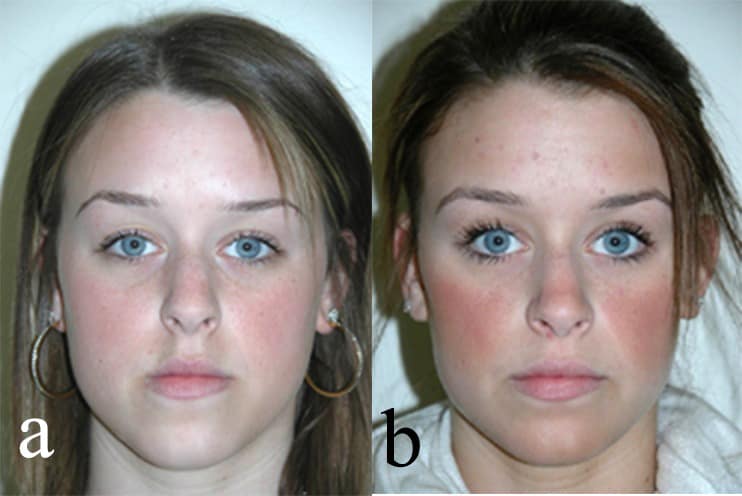
For instance, take a look at the photo above. The patient had a malocclusion with poor support to the alar base. The surgery corrected the malocclusion and added support, which slightly made her nose look yet enhanced her facial harmony.
Other than the type of surgery, the changes in your nose will also greatly depend on the extent and direction of the movements made. For instance, a vertical movement in your jaws would make fewer changes than an anteroposterior one. However, how much change will still heavily depend on how much movement occurred in the procedure.
Nose Aesthetics and Double Jaw Surgery
In some cases, jaw surgery can directly affect the way your nose looks. While it may not change the actual structure of your nose, it can change the position of your nose.
For instance, let’s say you got double jaw surgery. Double jaw surgery means that your maxilla will get moved as well.
If a surgeon moves the maxilla forward and slightly tilts it downward, the nose tip may move up slightly, and your nostrils may move forward a bit. The maxilla and nose are part of your midface, so moving the maxilla can also slightly move your nose.
For instance, check out this photo of a man before and after double jaw surgery.
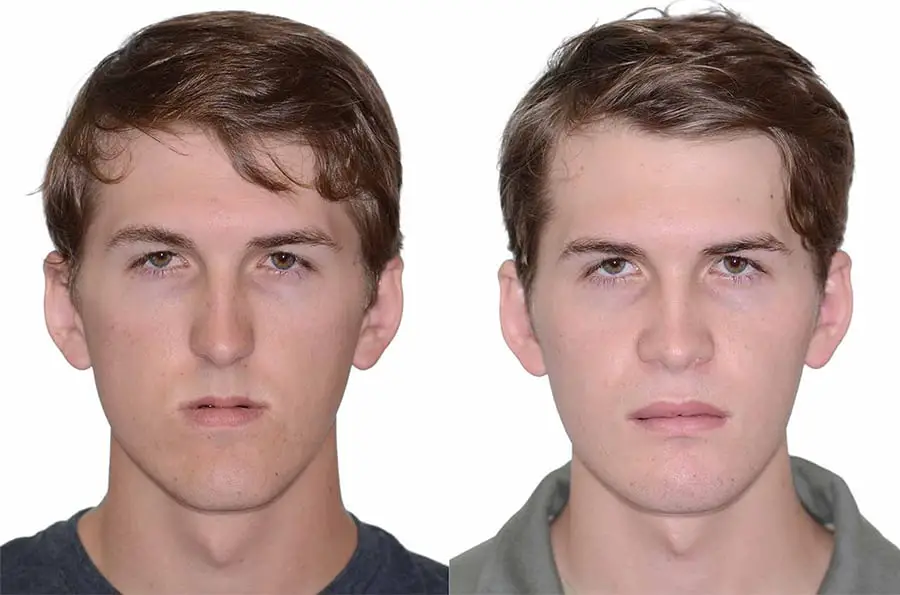
In the first photo, his nose looks very narrow. His nose got broader after double jaw surgery, but the change greatly enhanced his facial harmony.
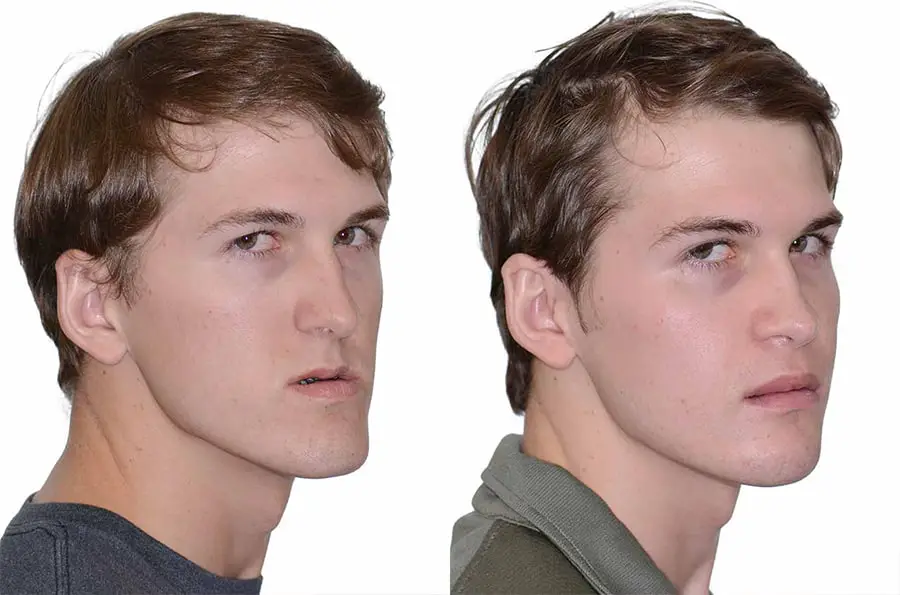
From the photos above, we can see that the patient’s nasal tip changed. The nasal tip is now upturned, further improving his side profile.
It is also important to note that surgery on your upper jaw can change the function of your nose. The maxilla supports your nasal airways, so changing the position or widening the maxilla can change the way you breathe.
It is likely that your doctor will make sure you breathe similar to before, or even better. How much of the function or appearance of your nose changes will vary greatly on how the maxilla is moved. However, many patients usually have positive changes in the function and appearance of their nose after jaw surgery. Of course, it will also depend on some specifics that your doctor will likely tell you about before the surgery, but most of them will likely benefit you.
For example, a patient will likely have a narrow nose if they have excessive vertical maxillary growth because the patient may often breathe through the mouth. The patient may notice that their nose slightly widens after surgery. That change can benefit the patient because it enhances their facial harmony and improves their respiratory function.
The most common soft tissue changes related to upper jaw surgery happen in the nose. These can include the nasofrontal angle, nasal position, height of the upper lip, alar base width, nasolabial angle, and the nasal tip projection. Again, these changes will likely be very minor.
The Most Common Nasal Change After Jaw Surgery
One of the most common changes after jaw surgery is the widening of the alar base, which is seen after nearly all maxillary osteotomies, particularly with advancement and/or impaction or segmental advancement and widening.

It is also very common to see a wider alar base occur from surgically assisted maxillary expansion. Since the nose and maxilla are in the same area, the broadening of the alar base will follow the expansion of the maxilla.
Typically, maxillary advancement makes the nose more upturned, as most patients see an increase in their nasolabial angle.
Patients may notice that there is a decrease in their nasolabial angle after maxillary impaction. They may also notice that their nasolabial groove gets accentuated and deepened. Inferior and/or posterior maxillary repositioning often leads to an increase in the nasolabial angle.
If you get a Maxillary Le Fort I osteotomy, it may have very minimal effects on your nasal bridge. If the nasal bridge looks different, it is likely because of a change to the nasal tip, and it may be perceptual.
For instance, your nasal bridge may look more prominent if you have a droopy nasal tip. The hump will look less noticeable if the tip rotates and projects upward. The bridge of your nose may look flatter if you get maxillary advancement when your dorsal nasal profile is low.
Effect of Mandible Surgery on the Nose
Surgery on your mandible may not have an actual effect on your nose. The maxilla is part of your midface with your nose, but the mandible is part of your lower face. Jaw surgery (especially on your maxilla) may change the facial harmony between your nose and jaw. However, surgery on the mandible is unlikely to shift the position of your nose.
Alar Base Cinch Suture
Some doctors may suggest an alar base cinch suture to prevent the broadening of the nose post jaw surgery. Some patients may experience “flaring nostrils” after a maxillary osteotomy, so the idea behind the suture is to keep the nostrils from expanding.
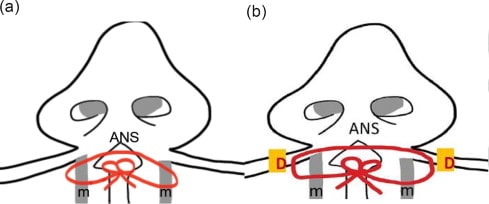
Jeong et al., 2017 looked at the correlation between maxillary movement and nasal soft tissue changes, including alar base widening. The researchers also investigated the possible effects of the cinch suture by monitoring the long-term change of the alar base width.
In the study, there were 52 subjects who got bimaxillary orthognathic surgery, including mandibular ramus surgery and Le Fort I osteotomy (which is commonly associated with alar base widening). The researchers took measurements before surgery, a month after surgery, and a year after surgery.
That study found that there was not much correlation to changes in the nose, including alar base widening. However, the researchers are claimed that it is hard to determine if the lack of changes is due to the alar base cinch suture.
Raithatha et al., 2017 also assessed the long-term effectiveness of the alar base cinch suture after a Le Fort I osteotomy. There were 140 participants, 16-51 years old. 106 of them got cinch sutures while 36 of them did not.
The researchers took anthropometric measurements before surgery, immediately after surgery, and up to three years after surgery. They found that cinch sutures reduced the width of the nose back to the measurements before surgery, and did so very well. Additionally, they noted that the alar base width was stable for over three years.
There was relapse found in some patients, but it was less than 1mm in the two parameters measured. Therefore, this study suggests that the alar base cinch suture could decrease your chances of having a wider nose after upper jaw surgery.
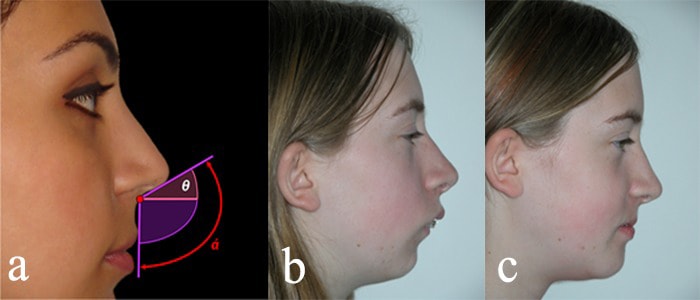
Is There a Way to Know What My Nose Will Look Like After Jaw Surgery?
You will likely know what your nose could look like post-operation from your doctor. They normally present you with images of your face after the surgery. While it may not be entirely accurate, it can give you a rough estimate. Just don’t rely on the pictures too much; they are largely marketing material. No surgeon can know exactly how you’ll look like after surgery.
What If I Do Not Like The Way My Nose Looks After Jaw Surgery?
Your surgeon will likely foresee any issues that could arise after your jaw surgery. They will probably prepare a treatment plan to correct the issues after surgery. If time passes and you are not happy with your nose after surgery, you can easily ask your doctor if you can get rhinoplasty.
It may be more ideal to get rhinoplasty post-surgery because the surgeon can make sure that your nose-to-jaw relationship is good, and this gives time for any swelling to decrease.
You may not always need to get surgery either if you do not want to go under the knife again. If you need a minor enhancement, you can opt for fillers to reshape your nose as needed to get a quick fix.
Other Ways Jaw Surgery Changes Your Face
Cheekbones
Your upper jaw and cheekbones are part of your midface. When you move the upper jaw, it is highly likely that your cheekbones will look different as well.
For instance, the photo below shows a man before and after double jaw surgery.
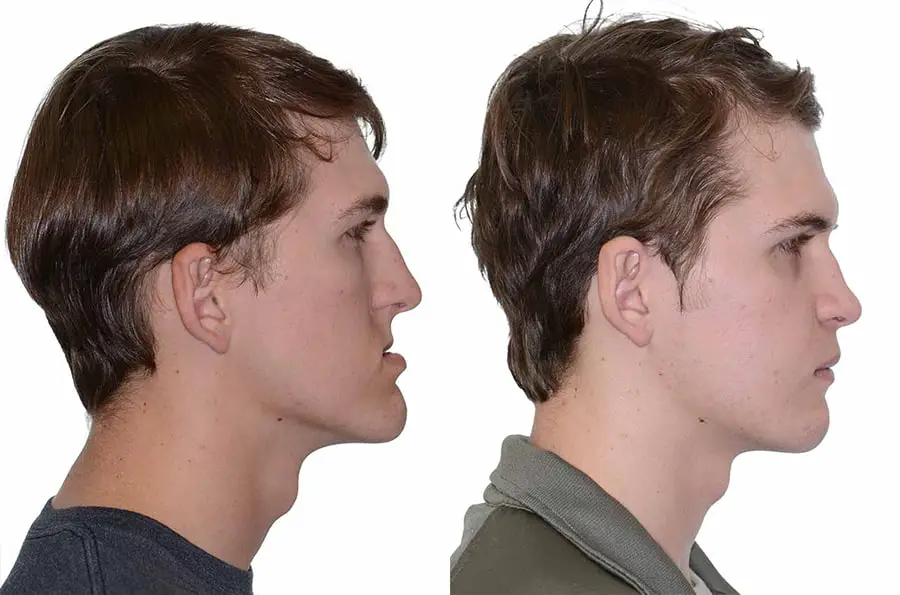
His cheekbones looked sunken, which was further emphasized by his protruding mandible. By moving the maxilla forward and the mandible back, it enhanced his cheekbones by pulling his cheekbones forward.
Better Lips
Jaw surgery realigns your teeth and mouth. When your jaws and teeth align properly, it is likely that your lips will fit well together, resulting in a better lip shape.
A Protruding or Weak Chin
In the case of mandible surgery, it will likely enhance your chin as well. Since your chin is part of your lower jaw, any movement to the lower jaw can change the way your chin looks.
For instance, pulling the mandible forward can make your chin look more pronounced. On the other hand, a surgeon may pull the jaw backward to fix a protruding chin. However, if that’s the case you should look for a different surgeon. Moving either of your jaws backward creates less space in your mouth, increasing your future risk of sleep apnea and hurting your facial aesthetics.


